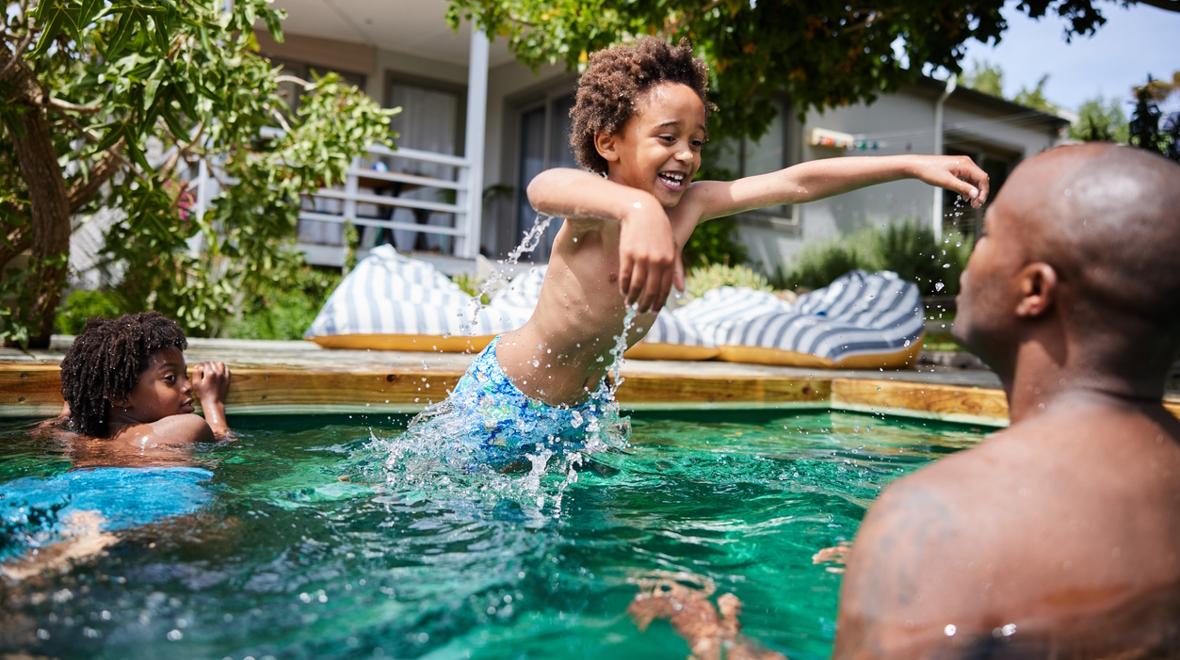
Photo:
credit: istock/Goodboy Picture Company
Summer in the Pacific Northwest means plenty of family time near, on or in the water. After all, we’ve waited all year for the temperature to climb high enough to be considered swimsuit-wearing weather, and seemingly everyone is ready to hop into a swimming pool, river, lake or ocean.
But wait! Let’s pump the brakes for a moment. As a parent, you know on an intuitive level that water safety is important, and that instinct is confirmed by fact: Drowning remains the leading cause of death for children ages 1–4.
While pools and waves are incredibly attractive to kids, water will always win without proper parental intervention.
Basic water safety skills save lives and unlock hours of secure play in nature. Studies show that swim lessons can reduce the risk of drowning by as much as 88 percent. But let’s go beyond swim lessons to really think through water safety basics before pressing play on a summer of splashing about in sparkling water.
The following is expert advice, based on an interview with child water safety expert Dr. Molly O’Shea, a nationally renowned pediatric medical consultant.
Adult supervision at all times
The first and arguably best tip for a safe summer is completely free: It’s your undivided attention. Water-based accidents can happen in the time it takes to snap a beach selfie. Keep your eyes on your child at all times if there isn’t a lifeguard present.
O’Shea recommends that you recruit an alternate grown-up to help watch your kids, because parents can start to lose focus after 15 to 20 minutes.

Make water less attractive
If you live within easy access to water, O’Shea recommends that you install high locks on your doors. An alarm may also be necessary. “Do anything you can to make the water less attractive,” recommends O’Shea. “Take toys out of the water. Let siblings know that they will never get in trouble if they report to you that their brother or sister leaves the house.” These intentional barriers can save lives.
Swimming lessons and safety gear
“You don’t think twice about car seats,” O’Shea reminds parents. “Swim lessons are just as important.” She recommends that parents have their kids start swim lessons when they are between 12 and 18 months of age. Moreover, ongoing swim lessons may be necessary to refresh water safety skills. “Kids need an automatic response to immersion. They need to be able to float and automatically turn on their back. It needs to be reflexive.”
Next, invest in proper water safety gear. Super obvious, but oh, so important.
Everything you need is readily available in any department store with a sporting goods section. If you’re on a budget, you can surf around Facebook Marketplace, OfferUp, Buy Nothing or a local used sporting goods shop, such as Second Gear Sports, for gently used gear that’s free or costs less than the new version. Kids are always outgrowing their life vests, so you can find secondhand flotation devices for a steal by searching through peer-to-peer sales apps.
Life vests are a must. According to the National Drowning Prevention Alliance, there are several factors to consider when selecting a personal flotation device (PFD). Check that the life jacket is approved by the U.S. Coast Guard. Life jackets come clearly marked with a weight range. Be sure your child’s jacket matches their current weight. And have your kid actually try on the life jacket to see if it fits — especially if they haven’t worn it since last summer, because (spoiler alert) kids grow like weeds!
Another consideration is the type of life jacket to buy. There are three types (Types I, II and III), each designed for different water-based activities. For example, Type III is designed for kayaking and water skiing because it’s comfortable, offers range of motion and keeps kids floating upright when immersed in water. Know your activity and pick your PFD accordingly.
As for water wings, O’Shea says to throw them out. They aren’t endorsed by the Coast Guard because they can easily be punctured or slip off your child’s arms.
Consider proper footwear for rocky, barnacle-covered Pacific Northwest beaches. The shorelines of the Salish Sea aren’t exactly a palm-tree-and-sand picture postcard setting. When beachcombing or wading just offshore, it’s easy for kids to cut their feet on razor sharp barnacles, crab exoskeletons, discarded glass, shell fragments or simply jagged rocks. Make sure your kid is properly shod in water-friendly footwear with a good tread to grip seaweed-covered rocks; think Keen sandals, aqua shoes with a thick sole or Crocs.
One modern tool to add to your store of safety gear is a GPS watch. If your child is setting out to sea in a kayak or on a stand-up paddleboard, be sure they have a waterproof smart watch strapped to their wrist. In the event that they are swept off course, you’ll be able to find their position by tracking them on your phone. This peace of mind doesn’t have to break the bank, either. Generic smart watches are available for reasonable prices online.

Waves and weather
Before hitting the beach, take a look at the tidal forecast; the National Oceanic and Atmospheric Administration (NOAA) offers updated tidal charts. How do tides factor into water safety? Undulating high tides can push swimming kids onto sharp shoreline rocks. Changing tides can cause strong, swift currents, which can push and pull watercraft off course or make it challenging to row to shore.
If you’re new to watercraft, you’ll want to first practice on a calm surface, such as a lake or a pond, before attempting to navigate the temperamental waters of Puget Sound.
Always take weather into consideration. In short, know your environment at all times and you’ll be able to foresee any peril that may threaten your chill day at the beach.
Know your limits
Help your older kids to understand their physical and technical limits. No one is born an Olympic swimmer or an endurance athlete ready to row a hundred miles up the shoreline. Self-awareness is key. Before children paddle offshore, be certain they have the strength and know-how to get back to their starting point.
Low-risk alternatives
Maybe you have a toddler or an ambulatory child who isn’t ready for immersion or a water safety class. Don’t worry. There are still plenty of options available for getting wet. Consider a good romp at a local splash pad. Also, sprinklers can provide an afternoon of low-risk fun in the backyard. Or dip your feet into a shallow kiddie pool, but please keep in mind that kids can drown in only 2 inches of water. As a precaution, secure your backyard from any potential drowning hazards, such as ponds and 5-gallon buckets.
If you’re concerned for your child’s safety near water, take some comfort in that feeling. Your alertness and vigilance can save lives.
Now get out there and have some summer fun, secure in the knowledge that you’ve done your due diligence.
More ideas for safe fun in the water: |











